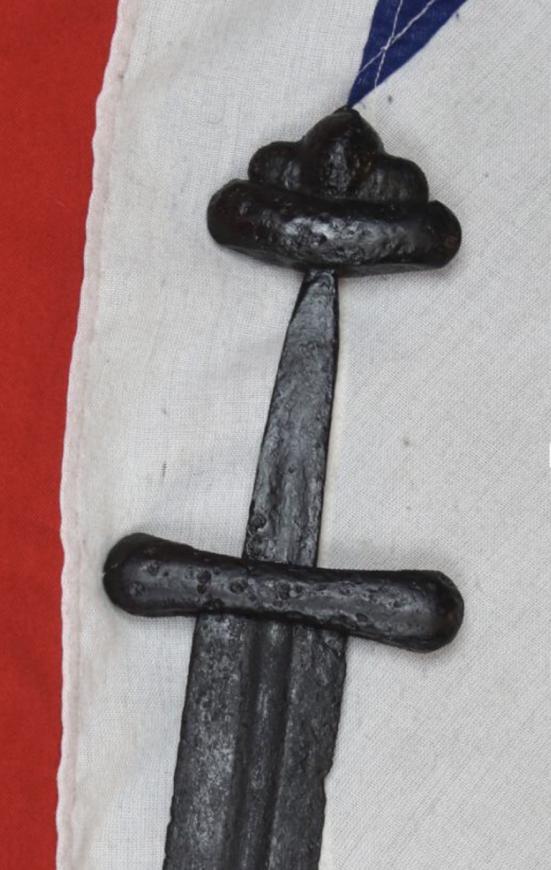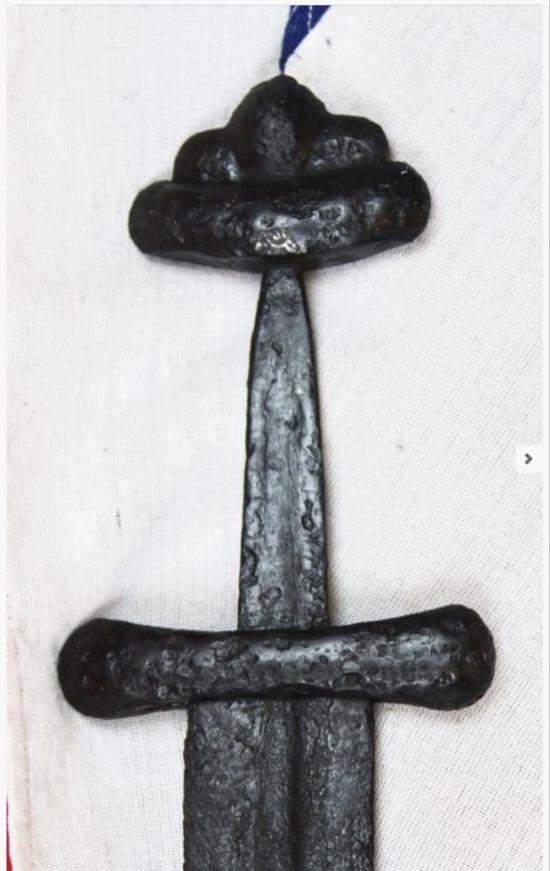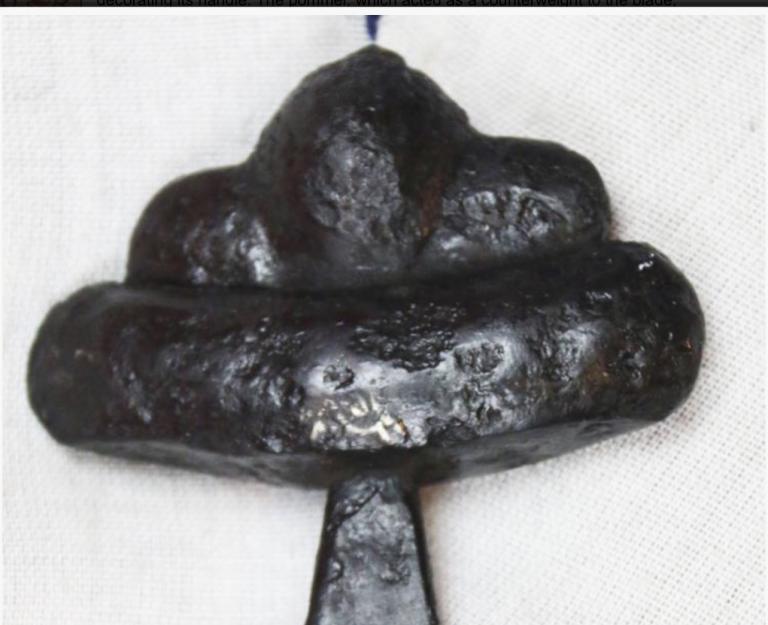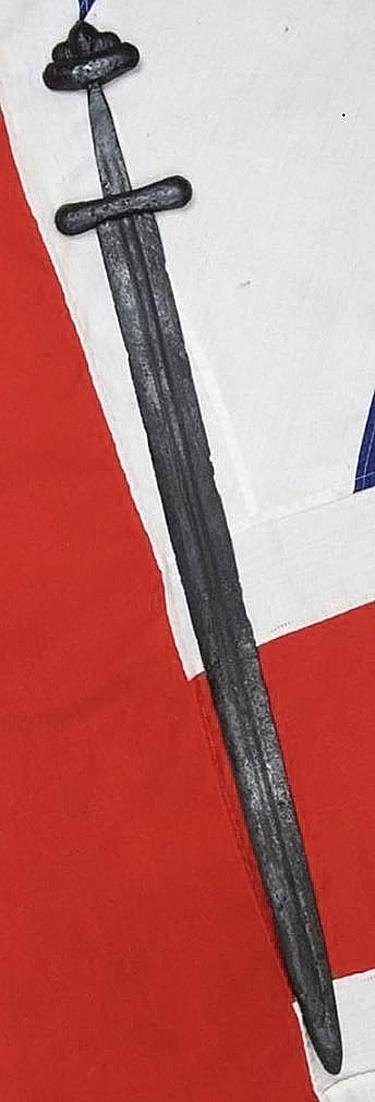A Singularly Fine and Rare Museum Quality Original Viking Jarl’s Sword Around 1100 years Old. Only The Third we Have Seen These Past 20 Years In Such Fine Condition. A Truly Fine & Rare Historical Piece
10th century. Around 1,100 years old, and we have hardly ever seen a better example in over 50 years
A Jarl is the rank of Earl in Viking hierarchy. Original Viking swords so rarely appear that we are only fortunate enough to acquire such a beautiful example thanks to our unique contact base forged over the past 50 years, we have had the extraordinary privilege to have had.
What a fabulous original ‘statement piece’ for any collection or decor. In the world of collecting there is so little remaining in the world from this highly significant era in European and British Viking history. And to be able to own and display such an iconic original representation from this time is nothing short of a remarkable privilege. A wonderful example piece, from the ancient knightly age. Effectively, from this time of almost a thousand years ago, from a collectors point of view, nothing else significant survives at all, only the odd small coin or very rarely seen, and almost impossible to own, carved statuary. It is said that the Viking sword occupied the highest rank of esteem in the forms of weaponry in the Viking age. It was certainly not a common weapon for the regular Viking warrior. Only the Viking earls, clan chiefs and kings normally carried such fine swords, for only Vikings of such status could afford the finest craftsmanship found in the Viking sword. The more usual weapons in the Viking warrior community were axes and spears. Circa 900 ad. Amazingly with traces of its original silver inlay in the base of the obverse side of the pommel. This pommel style was actually of Anglo-Saxon design, but it’s beauty was recognised by the Vikings and thus emulated in their swords. The Viking’s sword was a highly expensive weapon and therefore much effort was put into decorating its handle. The pommel, which acted as a counterweight to the blade, so that the sword balanced, could display inlays of precious metals or intricate patterns. The blade itself often had so called “blood grooves” or fullers, and this sword has a single fuller running along its middle. These fullers saved valuable metal and made the sword lighter. A sword might be the most expensive item that a man owned. The one sword whose value is given in the sagas (given by King Hákon to Höskuldur in chapter 13 of Laxdæla saga) was said to be worth a half mark of gold. In saga-age Iceland, that represented the value of sixteen milk-cows, a very substantial sum.
Swords were heirlooms. They were given names and passed from father to son for generations. The loss of a sword was a catastrophe. Laxdæla saga (chapter 30) tells how Geirmundr planned to abandon his wife Þuríðr and their baby daughter in Iceland. Þuríðr boarded Geirmund's ship at night while he slept. She took his sword, Fótbítr (Leg Biter) and left behind their daughter. Þuríðr rowed away in her boat, but not before the baby's cries woke Geirmundr. He called across the water to Þuríðr, begging her to return with the sword.
He told her, "Take your daughter and whatever wealth you want."
She asked, "Do you mind the loss of your sword so much?"
"I'd have to lose a great deal of money before I minded as much the loss of that sword."
"Then you shall never have it, since you have treated me dishonorably The Vikings placed such status on to their swords they often named them, due to the belief of theIr supposed magical qualities, heritage, and creator of remarkable events. Such evocative names as;
Gramr: Fierce. This was the name of the sword that hero Sigurd used to kill the dragon Fafnir
Gunnlogi: Battle Flame, War Flame
Leggbir: Leg bitter
Skrofnung: Gnawer
Keurnbut: Millstone-breaker
Naegling: Hole-maker
Fotbitr: Foot-biter.
Swords that had names were a treasure not only for their monetary value but also for the honour for the family and the clan.
This fabulous sword is in amazing condition and considering its great age is remarkably sound indeed, and feels just as a fine top quality sword should, even today. It is 10th century, and likely used up to, and into, the 11th century 'Battle of Hastings' of 1066, known as the the Norman invasion period. This wonderful museum piece is part of a significant collection of fine museum quality swords. Swords from the 10th to the 12th century of British history, used in the Battle of Hastings invasion period and into the earliest part of the new British Norman age, and it was used by the invading Norman knights that ruled England after conquering the Anglo Saxon King Harold. The other Norman swords we are added were used into the later early Norman period, in the Crusades period, in the reign of his sons Kings William The IInd, Henry The 1st , his successor Stephen, and the first Plantagenet, Henry the IInd and his son King Richard the Ist. This fabulous, historical Viking sword, has the highly iconic, and typical trilobite fashion, pommel of three distinct lobes, inlaid with silver. A double-edged broad sword of Petersen Type S variant with a tapering blade, shallow fullers, possible traces of pattern-welding to the blade, it has superb battle nicks to both cutting edges; a boat-shaped upper and lower guard with splayed ends, the massive Viking pommel with is with three distinct lobes. It is 1.2 kg, and 92cm (36 1/4") Long. In fine condition.
Literature
See Petersen, J., De Norske Vikingsverd, Oslo, 1919; Peirce, I., Swords of the Viking Age, Suffolk, 2002; Hiardar K. and Vike, V., Vikings at war, Oxford-Philadelphia, 2016; the sword has good parallels with similar Viking age specimens published by Peirce (2002, pp.102-105), one in the British Museum and the other at the Universitetets Oldsaksamling, Oslo.
Footnotes
Viking swords of Type S are commonly found in Nordic countries and Eastern Europe, with a number found in Western Europe. Although this sword would be classified as a Type S, the trilobate form of the pommel recalls the swords of type L, having Anglo-Saxon influences. The style of the hilt on the S swords are often very different: so were the swords, that can combine elements of different types. In the gallery we show an original medieval painting of 11th century King Harald in combat at Stamford Bridge in 1066, and note the knight behind is using the very same type of lobed pommelled Viking broadsword. Illustration by Matthew Paris from "The Life of King Edward the Confessor", 13th century. A most similar sword but in much poorer condition is known as the Roselund Sword. In the Church of Rønninge stands a rune stone bearing the text: “Sóti placed this stone in memory or Eileifr, his brother, Ásgautr Red-shield’s son”. Nearby lies the Rosenlund grave containing weapons and riding equipment, perhaps it was Ásgautr’s grave. We are familiar with Viking swords from various burials, which mainly date to the early Viking period. It was most often people of high status who were buried with swords in the Viking Age. Not all Viking warriors had a sword; they were prestige weapons. Swords were highly valued objects and could be handed down from generation to generation. They were also given as gifts to people of high status in order to stay on good terms with them.
Viking swords were also used in another way. This was the tradition of sacrificing the valuable swords in lakes and bogs. Many swords, spears and lances from the Viking and early medieval periods have also been found near fords crossing rivers and in wetlands. Perhaps the weapons were left at such locations as an offering, or else they were simply dropped and lost during the attempt to cross the water. One picture in the gallery is an early painting of the Anglo Saxon King Offa of Mercia on horseback, he is holding a near identical sword with the same triple lobed pommel as this Viking sword has. Almost every weapon that has survived today from this era is now in a fully russetted condition, as is this one, because only the swords of kings, that have been preserved in national or Royal collections are today still in a good state and condition We will include for the new owner a complimentary wooden display stand, but this amazing ancient artefact of antiquity would also look spectacular mounted within a bespoke case frame, or, on a fine cabinet maker constructed display panel.
Overall 29.25 inches long
Code: 23537






